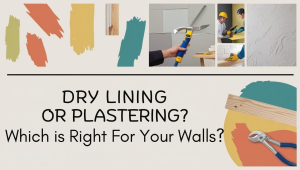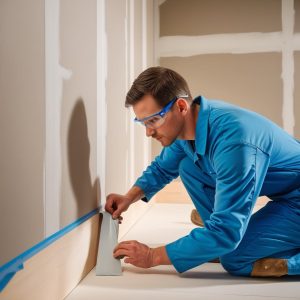When it comes to finishing your walls, two common techniques are dry lining and plastering. While both methods help to create smooth, finished surfaces, they differ significantly in terms of the materials, process, and results. Understanding these differences will help you make the best choice for your property. In this post, we’ll explore the key distinctions between dry lining and plastering, outlining the advantages and ideal situations for each technique.

What is Dry Lining?
Dry lining is a technique used to cover the interior walls and ceilings of a property with boards, typically made of plasterboard, which are secured to the existing structure using fixings. The most common materials used in dry lining include plasterboard, foam boards, and insulation boards. Dry lining is a fast and effective method, commonly used in modern construction due to its ease of installation and ability to provide additional insulation.
Typical Applications:
Dry lining is ideal for both residential and commercial properties. It is particularly useful when you need to create a smooth, durable finish on new builds or when renovating existing spaces. It can also provide thermal and sound insulation, making it popular for creating comfortable living environments.
What is Plastering?
Plastering involves applying a wet mix of plaster over a surface, such as a wall or ceiling, to create a smooth, durable finish. The plaster is spread in layers over a prepared surface, and once it dries, it hardens to form a solid, seamless coating. There are various types of plaster used in the process, including traditional gypsum plaster, lime plaster, and modern plastering compounds.
Typical Applications:
Plastering is often used in older buildings, where traditional techniques and materials are needed to preserve the integrity of the structure. It’s also used in homes requiring a highly polished, smooth finish, such as in high-end renovations or properties with intricate detailing.
Dry Lining vs Plastering: Key Differences
Materials Used:
Dry lining primarily uses plasterboard, which is easier to handle and install compared to the wet plaster used in plastering. Plastering, on the other hand, relies on a mix of powdered plaster and water, which is applied directly to the wall.
Process Differences:
Dry lining is a relatively quicker process as it involves attaching pre-made boards to walls, which can be done in a single day. In contrast, plastering is more time-consuming, as multiple layers of plaster must be applied and allowed to dry before the surface can be finished.
Durability and Finish:
Both methods provide a smooth, durable finish, but plastering tends to offer a more solid and long-lasting surface. Dry lining, while durable, may show signs of wear more quickly, especially in high-traffic areas. However, it offers the benefit of being easier to repair or replace.
Cost and Time Considerations:
Dry lining is often a more cost-effective solution due to its faster installation time and simpler process. Plastering, being more labour-intensive and time-consuming, can be more expensive, but it provides a higher-quality finish that can last longer.
When to Choose Dry Lining vs Plastering?
Ideal Scenarios for Dry Lining:
- New-build homes or commercial properties where speed and efficiency are a priority
- Spaces that require added insulation, such as basements or rooms with soundproofing needs
- Budget-conscious projects that need quick turnarounds
Ideal Scenarios for Plastering:
- Older homes where traditional materials are required to maintain the authenticity of the property
- High-end renovations where a polished, seamless finish is important
- Projects that require a durable, long-lasting surface
Benefits of Each Method:
Dry lining offers speed and simplicity, making it a great choice for cost-effective projects. Plastering, while more expensive and time-consuming, delivers superior results and durability for those seeking a long-lasting, refined finish.
Conclusion
Choosing between dry lining and plastering depends largely on the nature of your project, budget, and desired results. If you need a fast, cost-effective solution for modern properties, dry lining is a solid choice. However, if you’re looking for a high-quality finish that lasts for years, plastering may be the better option. Understanding these key differences will ensure you make the best decision for your property’s needs.


